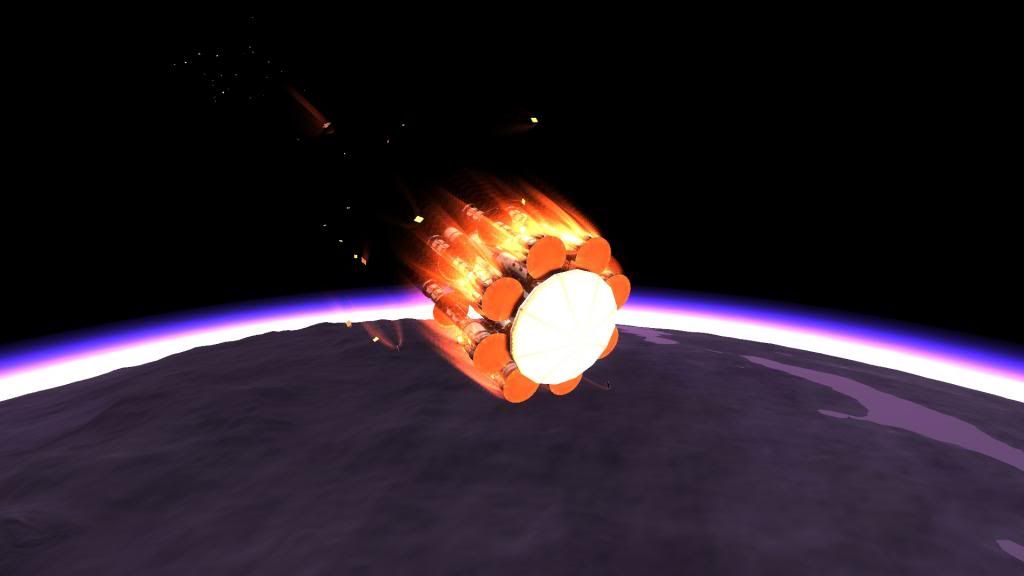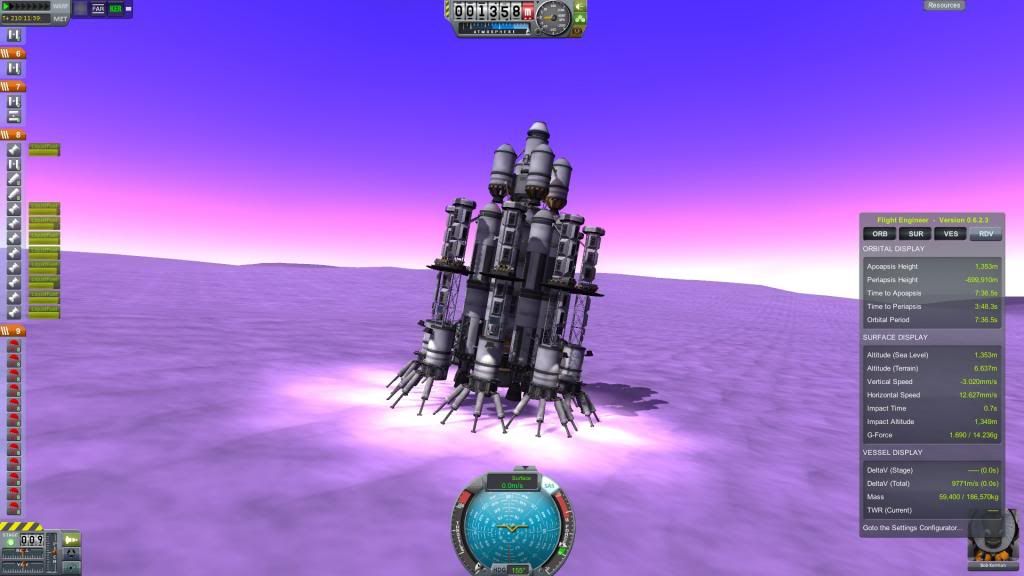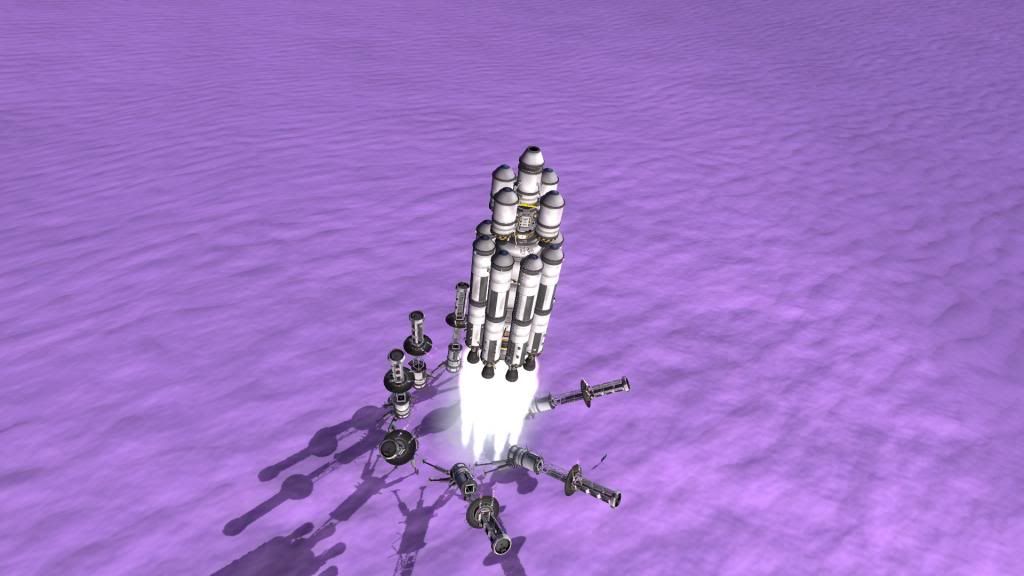

Lukaszenko
-
Posts
365 -
Joined
-
Last visited
Content Type
Profiles
Forums
Developer Articles
KSP2 Release Notes
Bug Reports
Posts posted by Lukaszenko
-
-
So I tried playing with no reaction wheels for more "realism", and I learned that indeed suspension of realism is sometimes necessary in the interest of fun. But, at least now I know precisely why.
IRL they also spend countless man-hours optimizing trajectories and burns and timings, and when they finally perform them they know exactly when, where, and how long. In KSP, sometimes you make a burn, you overshoot, you turn around, then left and then right and then your're close enough....and I just spent half my ship's mass worth of RCS

-
I know real life reaction wheels saturate, but I've also been hearing that KSP ones are way overpowered and perhaps perform some other dubious physics tricks.
What are the real differences? How much overpowered are they? Could they be used IRL to stabilize an EVE ascending spaceship, for example?
If the differences between KSP and IRL are large, is there a mod to make them behave more realistically?
I'm basically trying to figure out if I should continue using reaction wheels as I have been, install said mod (if it exists), or ditch reaction wheels altogether and use RCS for realism.
I understand Newton's laws and all that, but when it comes to angular momentum and gyros and gimbals, it's still a bit tricky for me to wrap my head around how it all should work.
-
FYI, an extreme example of what the structural fairings let you push up into space:
Javascript is disabled. View full album
-
According to this, it was introduced in either version 1.2 or 2.2, but I'm not really sure how to interpret the version history notes.
Anyway, I don't recall ever reading about it. I just stumbled on the "Auto-strut" tweakable one day and that's how I figured it out, but it was definitely some time after I started using FAR.
-
That was certainly not the case when I had exactly the same problem as the OP with an interstage payload wobbling through the fairings. I had to strut the fairing bases togther to get the rigidity.
You sure you had two fairing bases facing each other? What you described sounds like a classic symptom of only having one fairing base. The behavior shows that the fairing is clearly more rigid than the payload, and it's just a matter of attaching the two together.
If not, perhaps your "Auto-struts" option was off? Or nonexistant, due to older version?
Javascript is disabled. View full album
-
Holy crap, if this is true I may have to start using procedural fairings instead of the KW fairings...
Of course it's true! Hell, you can even turn it off if you wish.

-
The fairings from Procedural Fairings can also be structural, which is relevant to OPs problem. The key is to put a second fairing base on top of the payload, facing down. The payload is then stiffly braced from top and bottom and all problems are solved...at least until the fairings are jettisoned
 . But, by then the problem is reduced because usually space engines don't make that much thrust. Nevertheless OPs rocket looks pretty extreme and could still benefit from a redesign as per other posters' suggestions.
. But, by then the problem is reduced because usually space engines don't make that much thrust. Nevertheless OPs rocket looks pretty extreme and could still benefit from a redesign as per other posters' suggestions.
-
My Eve lander was also highly unstable. I couldn't thrust all the way, especially in the lower atmosphere, and I couldn't even think about starting the gravity turn until waaaay high, like 30 km up. And even then that was after adding multiple reaction wheels.
-
Yes, that's another way to do it. Again, does the benefit outweigh the drawbacks in risk and complexity? What happens if the tether breaks? How do you perform correction burns with a bola arrangement?
I think of all the things that could break on a spacecraft, a tether is the simplest to design against. It's just a simple calculation that we could whip off in a minute on an envelope. There wouldn't even be any fatigue stresses. It just seems scarier than it should be simply because such a failure appears quite catastrophic.
-
I don't think you can have 1000x our intelligence without being able to manipulate the environment, or at least be able to put the intelligence to VERY good use.
There must have been an evolutionary feedback look between the dexterity of our hands/ our language/ our technology and intelligence. Otherwise intelligence, at least for humans, is way too expensive energetically to just go off on its own.
One recent theory I heard, for example, is that humans would never be able to evolve our level of intelligence without first being able to cook food. There is just not enough freed-up calories in uncooked food to support our brains.
-
Earths magnetic field, Its magnitude at the Earth's surface ranges from 25 to 65 microtesla, that's weaker than a bar magnetic, attempting to move a 500 ton object...
It simply isn't worth the cost
It's already moving. All you need to do is to balance out the air drag. My understanding, for example, is that ion engines are more than sufficient for this.
The fact that it's 500 tons is irrelevant. You've been playing too much KSP :-)
-
Except that total vacuum most likely does not exist outside a laboratory[/quote
Space has a better vacuum than any laboratory can achieve.
-
How do they do it in real life? Straight up they tweak the rotation to be exactly once per revolution?
-
I didn't want to start a new thread about this question, but this seems like a good place to attach it to: Why is terminal velocity in KSP given as a fixed speed at an altitude? Terminal velocity depends on shape and other factors. Does the basic KSP aerodynamic model essentially cancel out all those other factors and you end up with a simple velocity@altitute chart?
-
i've always been curious about gravity too, i assumed since you need to expend energy to fight it then it must require some energy itself to exert. this is not the case, yeah?
You don't need energy to fight gravity. You can rest a book on a table and it will sit there for as long as we please, fighting gravity, with no energy expenditure. You only need energy when you exert a force over a distance, but a force standing still, no matter how large, requires no energy.
As for gravity being atoms ripped apart, as far as I know there is no scientifically accepted theory that would agree with this, so it's safe to say "no" unless there can be provided some much deeper explanation backed up with math.
-
Any tips for getting 450 tons to orbit?
Yeah, don't
 ! Perhaps drain it of fuel before launching, and send the fuel later?
! Perhaps drain it of fuel before launching, and send the fuel later? -
That's one thing we were definitely "meant" to do: be curious. Exploring space is simply a manifestation of this basic human trait.
-
It's counterintuitive, but it's more efficient to come in as low as possible and burn slightly off-retrograde to keep your altitude constant as you slow down, rather than burning retrograde and allowing yourself to fall. The difference is more pronounced at lower thrust-to-weight ratio.
Wouldn't it be more efficient to start at an altitude high enough to be able to perform a pure retrograde burn the whole way down?
Starting "as low as possible" is nice but you have to get there first, and that takes fuel.
-
As Armchair Rocket Scientist implied, a rocket's miles per gallon efficiency starts at 0 and goes up to pretty much infinity. This makes me very curious during which portion of the rocket's flight was the "4.1 in/ gallon" figure averaged.
-
I find that even if the thrust perfectly lines up with the COM of the asteroid, the rocket starts bending once the engines fire, and the asteroid starts spinning. This is a function of how long and thin the rocket is, and how much thrust you're applying. Reducing thrust is probably the simplest way to avoid the rocket buckling.
Of course pulling the rocket apparently seems to work, but it doesn't seem realistic. I'm sure there's a distance by which the exhaust will disperse enough not to matter, but I'll also surmise that it's much longer than the exhaust plume.
-
Here's my contraption, although NOT purely stock as it has reinforced joints. Also it's built for FAR and DRE. Still should work on a stock game because that's where most of the testing took place. I finally installed reinforced joints because it took waaaay too long to test and retest (with no hyperedit) at a fraction of a frame/sec.
Anyway, it has ~12 km/s delta V and somehow had more than 3k left over when I reached orbit. I suspect FAR had something to do with it.



-
Adding 5 m/s on top of 4000 takes MUCH more energy than adding 5 m/s from standstill.
-
And a high TWR will also be helpful when landing. I had to waste a lot of thrust in the downward direction instead of purely retrograde due to inadequate TWR. Point is that on Tylo descent and ascent, a stronger engine might lose delta-v due to weight, but it will gain delta-v due to reduced gravity losses. Somewhere there is a balance, and I'm pretty sure it's not at a ~1 TWR.
-
Right, I've experienced it as well. But it really has nothing to do with "skipping like a rock". You're simply going through the atmosphere like a hot knife through butter.

Recovered parts and refunds.
in KSP1 Gameplay Questions and Tutorials
Posted
I actually ALMOST designed some nicely recoverable stages, but indeed it does require them pushing my ship (and therefore themselves) all the way to a stable orbit. It gave me a good use for the vernor engines to stabilize the usually long stage while landing ( I, and I wonder if the developers, got the idea from problems experienced and solved by SpaceX). The only thing I'm missing is a good set of landing legs that can survive reentry.